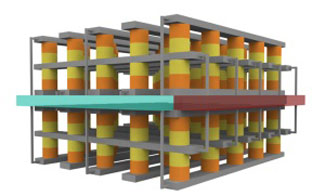| Oct 11, 2011 |
Irresistible memory
|
|
(Nanowerk News) Computing technology is currently based on two types of memory: the fast, volatile memory that is used to run applications, and the slower, non-volatile memory used for long-term data storage. The development of fast non-volatile memory to serve both functions could therefore lead to simpler and more powerful electronics. Myoung-Jae Lee and colleagues at Samsung Electronics and Sejong University in Korea have now taken a step towards realizing such a universal type of non-volatile memory with their development of fast, durable resistance-change memory ("A fast, high-endurance and scalable non-volatile memory device made from asymmetric Ta2O5-x/TaO2-x bilayer structures").
|
 |
| A schematic illustration of the stacked resistive memory structure for fast, durable resistance-change memory
|
|
Resistance-change random access memory (RRAM) typically consists of an insulating oxide between two metal contacts. Applying a 'set' voltage across the contacts causes the formation of conductive filaments through the oxide, switching it from a high-resistance state to a low-resistance state. A 'reset' voltage disrupts these filaments and returns the memory to its high-resistance state.
|
|
Lee and his colleagues modified this standard geometry by splitting the insulating oxide layer into two separate layers: a thicker, less-resistive layer consisting of TaO2–x, topped by a thin, highly resistive layer consisting of Ta2O5–x (see image). By tuning the thicknesses and resistances of these two layers, the researchers ensured that filament formation occurred entirely in the thinner layer, reducing the current necessary to put the device into its low-resistance state — a key requirement for scaling RRAM technology to high memory densities.
|
|
The researchers then devised a simple method for addressing individual memory cells in an RRAM array by adapting a standard 'crossbar' electrode geometry to avoid the requirement that every electrode intersection must have a diode or transistor to prevent cell cross-talk.
|
|
The resulting memory array was able to withstand 1012 switching cycles, which is about 100 times greater than previously demonstrated RRAM technologies and 1,000,000 times better than commercial flash memory — a typical solid-state non-volatile memory. The memory could be switched at speeds of up to 10 ns at a modest current of just 50 µA, with a retention time of more than ten years. "RRAM may find specific uses in mobile applications," says Lee, "but with improvement we hope that a working replacement for dynamic ram might be possible in the future."
|

